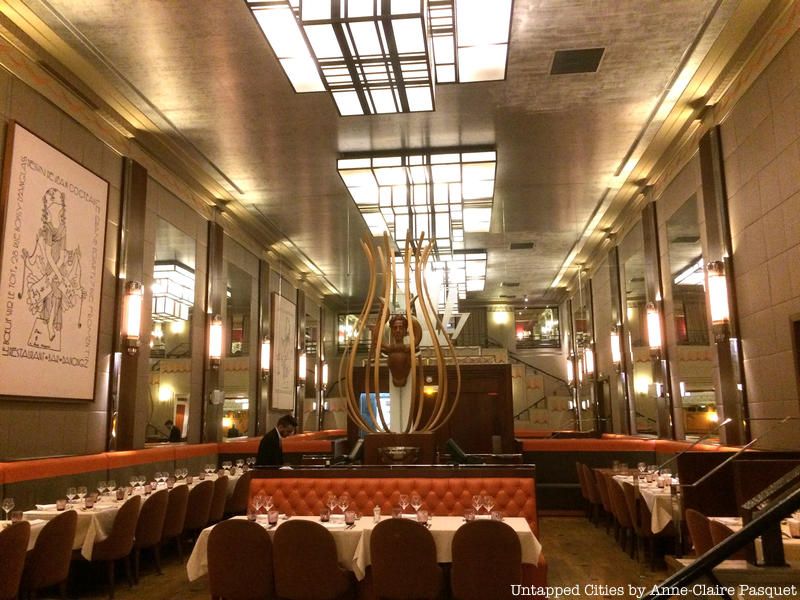Last Chance to Catch NYC's Holiday Notalgia Train
We met the voices of the NYC subway on our nostalgia ride this weekend!


Earlier this month, a new biopic about fashion designer Yves Saint Laurent was released in France. Yves Saint Laurent focuses on the relationship (both personal and professional) between Saint Laurent and his long-time partner Pierre Bergé. Bergé himself was involved in some of the filming and loaned 77 of the vintage costumes from the Fondation Pierre Bergé-Yves Saint Laurent.
Using locations from the fantastic book The Beautiful Fall by Alicia Drake, we’re sharing the haunts of Saint Laurent and Karl Lagerfeld during the decadent era of Paris in the 1960s and 1970s, as both designers were jockeying to get their careers started. The book is a must-read for lovers of Paris, fashion or both.
Cafe de Flore at St. Germain on the Left Bank was the place to see and be seen. As Drake describes, it “was the essence of all that was desirable on the Rive Gauche of Paris.” A mix of artists, literary types, models, celebrities and most importantly, for this story, muses to the creatives. This classic Parisian cafe still exists today, opposite the other literary stronghold, Les Deux Magots.

Drake writes that “both Yves and Karl were steeped in nostalgia,” yearning for the Paris of the 1920s and ’30s. Le Bœuf sur le Toit in the 8th Arrondissement off the Champs-Elysées was their favorite because it had been a “cult piano cabaret bar of Cocteau, Picasso and Chanel after the First World War.”
Le Fiacre was a small, but famous, gay nightclub on Rue Saint Sulpice on the Left Bank that got so crowded, the party would end up on the streets in the summer. Discussing the gay scene during this time, Drake says that “there were pockets of homosexual life and men cruising all over Paris, but Saint Germain in the 1950s was known for its folles, the name used to describe camp gays of the moment…”

Rue Saint Anne today
Rue Saint Anne was lined with gay clubs, but Le Sept was a game changer for the gay community. Located on Rue Saint Anne near Opera, it was, says Drake “homosexual in its inclinations and yet radically removed from the clandestine gay clubs of the Rive Gauche [Left Bank]… But the greatest innovation of Le Sept was that it was defined by glamour, not homosexuality. Everybody came–gay, straight and the undecided.” It was dark and small, and although it no longer exists, the piano bar just across the street still does. The dance pole on a tiny stage in the back, the carpeted floor, the basement lounge, and the unmarked door that leads out to a courtyard, all feel like remnants of an earlier era.
In
Life of Piby Yann Martel, he writes that Piscine Deligny—“Paris’ oldest pool dating back to 1796, was an open-air barge moored to the Quai d’Orsay and the venue for the swimming events of the 1900 Olympics.” It has a fascinating history, but came to a sad end when it sank to the bottom of the Seine in 1993. It was a place to be seen, as evidenced by visitors such as King Charles X, King Louis Philippe and writer Charles Sand, with a restaurant and private rooms.
Drake writes that “it was a fabulous haunt for picking up and posting… People would stare open-mouthed as Karl [Lagerfeld] strutted across the watermelon-pink wooden decking, wearing high heels and an all-in-one swimsuit.” See more of the amazing architecture at the pools of Paris here.
In the early days, when Karl Lagerfeld and Yves Saint Laurent were still friends, Karl would drive them in his car to La Closerie des Lilas for dinner. Like many of their other haunts, this restaurant has long list of historical figures as clientele, including Hemingway, Oscar Wilde, F. Scott Fitzgerald, Pablo Picasso, Jean-Paul Sartre, Man Ray, Modigliani and many more.
A scandalous, hard-core party was thrown in honor of Karl Lagerfeld in 1977 the night of a Chloé show at La Main Bleue. Located in the suburbs of Montreuil, the club was in fact one of Phillipe Starck’s first design projects and still can be seen on his website. Converted from a cinema, the place was “huge and concrete… a bleak hangar of a club with blue laser lights leading down the concrete staircase into darkness,” describes Drake.
Drake says Le Palace, opened by the same owner as Le Sept, was “Paris’ answer to Studio 54,” but much more hedonistic. With a capacity of several thousand, Le Palace was located in a former theater built in 1922 and refurbished at a cost of 15 million francs. There was a “strong pop and rock cultural thrust… over the years the club would feature a line-up of live performances by Prince, The Clash, Talking Heads, Blondie…” says Drake. The drug of choice on opening night was Bolivian officer’s coke that had a pale pink hue, mixed with cocktails and mescaline. In addition to the many fashion parties and masked balls thrown there, Le Palace was an after-dinner stop during the wedding party of Paloma Picasso, hosted at Karl Lagerfeld’s house in 1978.
Pick up The Beautiful Fall: Fashion, Genius and Glorious Excess in 1970s Paris by Alicia Drake for more of the drugs, sex and rock-roll in the over-the-top world of Paris fashion.
Get in touch with the author @untappedmich.
Subscribe to our newsletter